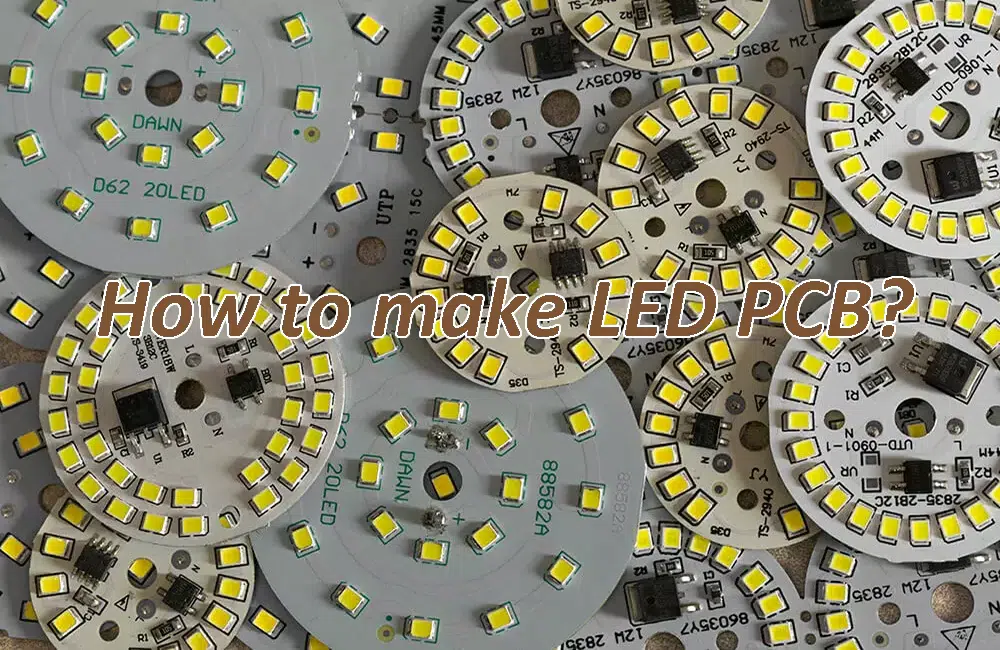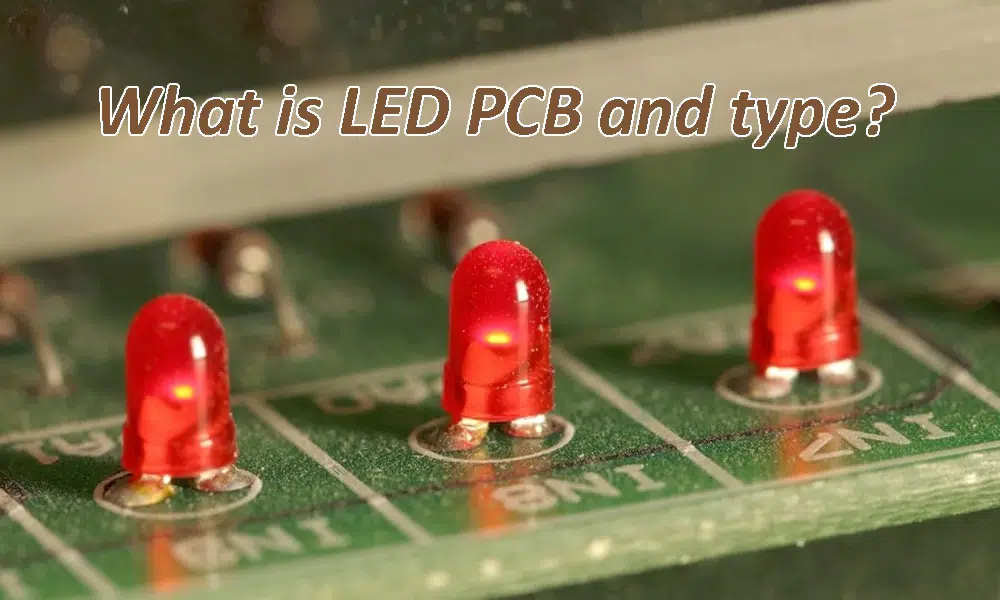LED PCB typically has copper traces and pads that serve as conductive pathways for electrical current. The LEDs are soldered onto these pads, and the circuitry on the board controls the flow of electricity to the LEDs.
The design of LED PCB can vary depending on the specific application and requirements. They may range from simple single-layer boards for basic LED applications to more complex multilayer boards for advanced LED lighting systems used in industries such as automotive, aerospace, and consumer electronics.
LED PCB plays a crucial role in the performance, reliability, and efficiency of LED lighting systems by ensuring proper electrical connections, thermal management, and overall functionality.
What is LED PCB ?
An LED PCB is a specialized circuit board designed specifically for mounting Light Emitting Diodes (LEDs). It serves as a platform for connecting and controlling the LEDs efficiently.
LED PCBs are used to power, control, and manage LEDs in various electronic devices and lighting applications. They provide electrical connections between the LEDs and other components, ensuring proper functionality.
What are the different types of LED PCB board?
LED PCB comes in various types, each designed to meet specific application requirements and performance criteria. Here are some common types of LED PCB :
1.Single-Layer LED PCB
These are the simplest type of LED PCBs, consisting of a single layer of conductive material (typically copper) with components mounted on one side. Single-layer LED PCBs are cost-effective and suitable for basic LED applications with minimal complexity.
2.Double-Layer LED PCB
Double-layer LED PCBs have conductive traces on both sides of the board, allowing for more complex circuit designs and higher component density. They provide improved routing flexibility and can accommodate additional components such as driver ICs and control circuitry.
3.Multi-Layer LED PCB
Multi-layer LED PCBs consist of three or more layers of conductive material separated by insulating layers (substrates). They offer even greater design flexibility, higher component density, and enhanced signal integrity compared to single or double-layer boards. Multi-layer LED PCBs are commonly used in advanced LED lighting systems and high-density electronic devices.
4.Metal Core LED PCB (MCPCBs)
MCPCBs have a metal core (typically aluminum or copper) as the base material instead of traditional fiberglass. The metal core provides superior thermal conductivity, allowing for efficient heat dissipation from the LEDs. MCPCBs are ideal for high-power LED applications where thermal management is critical, such as automotive lighting and industrial lighting.
5.Flexible LED PCB
Flexible LED PCBs are made from flexible materials (e.g., polyimide) that allow the board to bend or conform to curved surfaces. They are used in applications where space constraints or design flexibility are important, such as wearable electronics, curved displays, and automotive lighting.
6.Rigid-Flex LED PCB
Rigid-flex LED PCBs combine rigid and flexible PCB materials in a single board. They offer the benefits of both rigid and flexible PCBs, allowing for complex three-dimensional designs, reduced assembly complexity, and improved reliability. Rigid-flex LED PCBs are commonly used in applications where space is limited or where the board needs to bend or fold during operation.
7.High-Power LED PCB
High-power LED PCBs are designed to handle high electrical currents and power levels, typically used in applications requiring bright illumination or high luminous flux. These boards incorporate robust materials, efficient thermal management solutions, and specialized layout designs to ensure reliable performance under demanding conditions.
These are just some of the common types of LED PCB boards available in the market, each offering unique features and advantages suited to different applications and performance requirements.
What are the uses of LED PCB?
LED PCBs find diverse applications across various industries and sectors due to their versatility, efficiency, and reliability.Here are some common uses of LED PCBs:
General Lighting
Automotive Lighting
Backlighting
Signage and Displays
Decorative Lighting
Industrial Lighting
Specialized Lighting
Consumer Electronics
Emergency Lighting
Street and Area Lighting
These are just some of the many uses of LED PCBs across various industries and applications. Their versatility, efficiency, and reliability make them indispensable components in modern lighting and electronic systems.
How to make LED PCB?

1. Design the Circuit:
– Start by designing the circuit schematic using Electronic Design Automation (EDA) software like Eagle, KiCad, or Altium Designer. Lay out the components including LEDs, resistors, capacitors, and connectors.
2. Create the PCB Layout:
– Once the schematic is complete, transfer it to the PCB layout editor within the EDA software.
– Position components on the board, considering factors like size, placement, and routing to ensure efficient electrical connections.
– Route traces (conducting paths) between components, minimizing signal interference and ensuring proper current flow.
– Add necessary features like solder mask, silk screen, and drill holes.
3. Generate Gerber Files:
– After finalizing the PCB layout, generate Gerber files. These files contain all the necessary information for manufacturing the PCB, including copper traces, solder mask, and drill locations.
4. Manufacture the PCB:
– Choose a PCB manufacturing service or facility to produce the PCB according to your design.
– Upload the Gerber files to the manufacturer’s website or send them via email.
– Select options such as board material, thickness, surface finish, and quantity.
– Wait for the manufacturer to fabricate the PCBs. This typically involves processes like printing the circuit pattern onto a copper-clad laminate, etching away excess copper, drilling holes, and applying solder mask and silkscreen.
5. Solder Components:
– Once you receive the fabricated PCBs, it’s time to solder the components onto the board.
– Gather the necessary components including LEDs, resistors, and other components specified in your design.
– Use a soldering iron to solder the components onto the PCB according to the layout and schematic.
– Ensure proper orientation and alignment of the components, and follow best practices for soldering to avoid cold joints or solder bridges.
6. Test the Board:
– After soldering all components, test the LED PCB to ensure functionality.
– Apply power and verify that the LEDs illuminate as expected.
– Check for any shorts, open circuits, or other issues using a multimeter and visual inspection.
– Make any necessary adjustments or repairs if problems are detected.
7. Assemble the Final Product:
– Once the LED PCB is verified to be working correctly, it can be integrated into the final product or application.
– Depending on the application, additional assembly steps may be required, such as mounting the PCB in a housing, connecting external components, and testing the complete system.
By following these steps, you can create a custom LED PCB tailored to your specific requirements and applications.
What are LED circuit boards made of?
The structure of an LED PCB, or LED printed circuit board, typically consists of several layers that collectively provide electrical connectivity, thermal management, mechanical support, and protection for the LEDs and associated electronic components. Here’s a breakdown of the typical structure of an LED PCB:
1. Substrate Layer: The base layer of the LED PCB, known as the substrate, provides mechanical support and insulation for the circuit. Common substrate materials include fiberglass-reinforced epoxy (FR-4) for standard PCBs or metal core substrates (e.g., aluminum or copper) for LED PCB requiring enhanced thermal management.
2. Conductive Layers: LED PCBs typically contain one or more conductive layers made of copper that form the electrical pathways or traces for connecting the LEDs, electronic components, and power sources. These conductive layers are patterned using etching or deposition techniques to create the desired circuit layout.
3. Dielectric Layer: Between the conductive layers, a dielectric layer made of insulating material (e.g., epoxy resin) is present to provide electrical isolation between the conductive traces and prevent short circuits.
4. LED Mounting Pads: Specialized areas on the PCB, known as LED mounting pads or footprints, are designed to accommodate the placement and soldering of the LEDs. These pads are usually circular or rectangular in shape and are positioned according to the LED specifications and application requirements.
5. Thermal Management Layer: In LED PCB designed for high-power applications, a dedicated thermal management layer may be incorporated to efficiently dissipate heat generated by the LEDs. This layer often consists of a metal core substrate (e.g., aluminum) or a thermally conductive material (e.g., ceramic) to help transfer heat away from the LEDs to the surrounding environment.
6. Solder Mask: A solder mask layer is applied over the conductive traces to protect them from environmental factors (e.g., moisture, dust) and prevent unintended solder bridges during assembly. The solder mask is typically green in color but can also be other colors such as black, white, or blue.
7. Silkscreen: The silkscreen layer is used to print component designations, reference markings, polarity indicators, and other information directly onto the PCB surface. This layer aids in component placement, assembly, and troubleshooting.
8. Surface Finish: The exposed copper traces on the PCB surface are coated with a surface finish to protect them from oxidation and ensure good solderability during assembly. Common surface finish options include HASL (Hot Air Solder Leveling), ENIG (Electroless Nickel Immersion Gold), and OSP (Organic Solderability Preservatives).
By combining these layers in a well-designed structure, LED PCB can efficiently and reliably provide electrical power and thermal management for LEDs in various lighting and electronic applications. The specific configuration and materials used in an LED PCB may vary depending on factors such as application requirements, environmental conditions, and performance specifications.
LED PCB assembly manufacturer
LED PCB technology has been developed as an innovation for many new products. A good example is the development of PCBs for LED. The LEDs are soldered to the board and the chips produce light when they are electrically connected. Heat sinks and ceramic bases are used to connect the chips to absorb heat and cool.
IBE is a large, well-equipped PCB manufacturing and assembly factory. The assembled high-precision circuit boards are widely used in various fields such as aerospace, automotive, medical, and optical. As a solution for LED circuit boards with more than 18 years of experience, we are able to offer an integrated service for the PCB procurement, and assembly of components for LED PCB.
Conclusion
LED PCB represents a cornerstone of modern lighting, display, and electronics technology. Their innovative design, efficient operation, and versatile applications continue to drive advancements across various industries. As the demand for energy-efficient, high-performance lighting and display solutions grows, LED PCB boards are poised to play an increasingly pivotal role in shaping the future of illumination and visual communication.
An LED PCB is a specialized circuit board designed specifically for mounting Light Emitting Diodes (LEDs). It serves as a platform for connecting and controlling the LEDs efficiently.
1.Single-Layer LED PCB
2.Double-Layer LED PCB
3.Multi-Layer LED PCB
4.Metal Core LED PCB (MCPCBs)
5.Flexible LED PCB
6.Rigid-Flex LED PCB
7.High-Power LED PCB
LED PCBs find diverse applications across various industries and sectors due to their versatility, efficiency, and reliability.Here are some common uses of LED PCBs:
General Lighting
Automotive Lighting
Backlighting
Signage and Displays
Decorative Lighting
Industrial Lighting
Specialized Lighting
Consumer Electronics
Emergency Lighting
Street and Area Lighting











